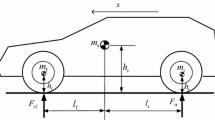Abstract
In vehicular radar servo system, parameter variations of the executive motor and external disturbance uncertainties have great effects on the position tracking precision of the system. In this paper, a robust adaptive controller with disturbance observer is designed for vehicular radar servo system, which combines the merits of disturbance observer, adaptive backstepping method and sliding mode control. The system is modeled, and a disturbance observer is employed to observe and compensate for the unknown uncertainties. Adaptive backstepping method is used to design the sliding model controller to guarantee the global stability of the overall system. Simulation results show that the proposed robust adaptive controller has good performance in position tracking and enhances the robustness of vehicular radar servo system while observing the uncertainties precisely and quickly.
Similar content being viewed by others
References
H. Y. Xue, Y. J. Li, and K. Zhang, “Variable structure control of radar servo system based on IMM,” ISECS International Colloquium on Computing, Communication, Control, and Management, Guangzhou, China, pp. 421–425, August 2008.
K. D. Young, V. I. Utkin, and U. Ozguner, “A control engineer’s guide to sliding mode control,” IEEE Trans. on Control Systems Technology, vol. 7, no. 3, pp. 328–342, 1999.
Q. P. Ha, Q. H. Nguyen, D. C. Rye, and H. F. Durrant-Whyte, “Fuzzy sliding-mode controllers with applications,” IEEE Trans. on Industrial Electronics, vol. 48, no. 1, pp. 38–46, February 2001.
M. Ertugrul and O. Kaynak, “Neuro sliding mode control of robotic manipulators,” Mechatronics, vol. 10, no. 1, pp. 239–263, February 2000.
F. J. Lin and W. D. Chou, “An induction motor servo drive using sliding-mode controller with genetic algorithm,” Electric Power Systems Research, vol. 64, no. 2, pp. 93–108, February 2003.
M. Mubin, K. Moroda, S. Ouchi, and M. Anabuki, “Model following sliding mode control of automobiles using a disturbance observer,” Proc. SICE Annual Conference, Fukui, Japan, pp. 1864–1869, August 2003.
J. K. Hwang, K. H. Oh, and C. K. Song, “Sliding mode control with disturbance observer for antilock braking systems,” Proc. of IEEE/ASME International Conf. on Advanced Intelligent Mechatronics, Monterey, US, pp. 277–281, July 2005.
K. Ito, H. Takahashi, S. Ikeo, and K. Takahashi, “Robust control of water hydraulic servo motor system using sliding mode control with disturbance observer,” Proc. SICE-ICASE International Joint Conference, Bussan, Korea, pp. 4659–4662, October 2006.
Y. Wu, W. Le, and D. Tian, “Application of sliding mode control based on disturbance observer on high performance flight motion simulator,” Proc. of the IEEE International Conf. on Automation and Logistics, Jinan, China, pp. 2695–2699, August 2007.
F. J. Lin, P. H. Shen, and S. P. Hsu, “Adaptive backstepping sliding mode control for linear induction motor drive,” IEE Proceedings: Electric Power Applications, vol. 149, no. 3, pp. 184–194, May 2002.
M. Smaoui, X. Brun, and D. Thomasset, “Systematic control of an electropneumatic system: integrator backstepping and sliding mode control,” IEEE Trans. on Control Systems Technology, vol. 14, no. 5, pp. 905–913, September 2006.
L. C. Baik, K. H. Kim, and M. J. Youn, “Robust nonlinear speed control of PM synchronous motor using adaptive and sliding mode control techniques,” IEE Proceedings: Electric Power Applications, vol. 145, no. 4, pp. 369–376, 1998.
A. Kawamura, H. Itoh, and K. Sakamoto, “Chattering reduction of disturbance observer based sliding mode control,” IEEE Trans. on Industry Applications, vol. 30, no. 2, pp. 456–461, March 1994.
Author information
Authors and Affiliations
Corresponding author
Additional information
Recommended by Editorial Board member Bin Jiang under the direction of Editor Young Il Lee. This work was supported by the Application Basis Foundation of Sichuan Province of China (No.2009JY0008) and the Excellent Youth Foundation of Sichuan Province of China (No. 09ZQ026-009).
Xia Liu is a Ph.D. student in the School of Automation Engineering, University of Electronic Science and Technology of China. Her research interests include nonlinear control and adaptive control.
Qi Huang received his Ph.D. degree from Arizona State University, USA, in 2003. He is currently a professor in the School of Automation Engineering, University of Electronic Science and Technology of China. His current research interests include power system high performance computing, power system instrumentation, power system monitoring and control, sensor network for electric power system security infrastructure, and integration of distributed generation into the existing power system infrastructure.
Yong Chen received his Ph.D. degree in Control Theory and Control Engineering from Chongqing University, China, in 2007. He is currently an associate professor in the School of Automation Engineering, University of Electronic Science and Technology of China. His research interests include intelligent control, image processing, information fusion and vehicle safety.
Rights and permissions
About this article
Cite this article
Liu, X., Huang, Q. & Chen, Y. Robust adaptive controller with disturbance observer for vehicular radar servo system. Int. J. Control Autom. Syst. 9, 169–175 (2011). https://doi.org/10.1007/s12555-011-0122-6
Received:
Revised:
Accepted:
Published:
Issue Date:
DOI: https://doi.org/10.1007/s12555-011-0122-6




